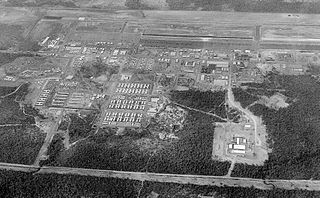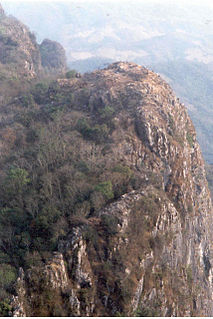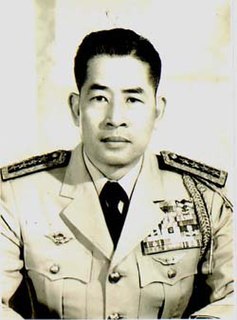Related Research Articles
The year 1970 in television involved some significant events. Below is a list of notable television-related events in that year.
Major-General Kouprasith Abhay was a prominent military leader of the Kingdom of Laos during the Laotian Civil War. Scion of a socially prominent family, his military career was considerably aided by their influence. In early 1960, he was appointed to command of Military Region 5, which included Laos' capital city, Vientiane. Removed from that command on 14 December for duplicitous participation in the Battle of Vientiane, he was reappointed in October 1962. He would hold the post until 1 July 1971, thus controlling the troops in and around the capital. Over the years, he would be involved in one way or another in the coups of 1960, 1964, 1965, 1966, and 1973. His service was marked by a deadly feud with another Laotian general, Thao Ma; the feud was largely responsible for the latter two coup attempts against the government.
The following outline is provided as an overview of and topical guide to the Vietnam War:

The Nakhon Phanom Royal Thai Navy Base (NKP), formerly Nakhon Phanom Royal Thai Air Force Base, is a Royal Thai Navy facility used for riverine patrols along the Mekong River. It is approximately 587 km northeast of Bangkok, 14.5 km west of Nakhon Phanom city in Nakhon Phanom Province in the northeastern region of Thailand, and 411 km from Hanoi in Vietnam. The Mekong River is NKP's border with Laos. The airfield at NKP is jointly used as a civilian airport.
Ubon Royal Thai Air Force Base is a Royal Thai Air Force (RTAF) facility located near the city of Ubon Ratchathani, in Ubon Ratchathani Province. It is approximately 488 km northeast of Bangkok. The Laos border is about 60 kilometres (37 mi) directly east. The facility is also used as a civil airport.

Fujio Akatsuka was a pioneer Japanese artist of comical manga known as the Gag Manga King. His name at birth is 赤塚 藤雄, whose Japanese pronunciation is the same as 赤塚 不二夫.

The Battle of Lima Site 85, also called Battle of Phou Pha Thi, was fought as part of a military campaign waged during the Vietnam War and Laotian Civil War by the North Vietnamese People's Army of Vietnam (PAVN) and the Pathet Lao, against airmen of the United States Air Force (USAF)'s 1st Combat Evaluation Group, elements of the Royal Lao Army, Royal Thai Border Patrol Police, and the Central Intelligence Agency-led Hmong Clandestine Army. The battle was fought on Phou Pha Thi mountain in Houaphanh Province, Laos, on 10 March 1968, and derives its name from the mountaintop where it was fought or from the designation of a 700 feet (210 m) landing strip in the valley below, and was the largest single ground combat loss of United States Air Force members during the Vietnam War.
Operation Barrel Roll was a covert U.S. Air Force 2nd Air Division and U.S. Navy Task Force 77, interdiction and close air support campaign conducted in the Kingdom of Laos between 14 December 1964 and 29 March 1973 concurrent with the Vietnam War.

USS Windham County (LST-1170), previously USS LST-1170, was a United States Navy landing ship tank (LST) in commission from 1954 to 1973 which saw service in the Atlantic, Caribbean, and Pacific and served in the Vietnam War.

Cao Văn Viên was one of only two South Vietnamese four-star army generals in the history of the Army of the Republic of Vietnam during the Vietnam War. He rose to the position of Chairman of the South Vietnamese Joint General Staff. Considered one of "the most gifted" of South Vietnam's military leaders, he was previously called an "absolute key figure" and one of "the most important Vietnamese military leaders" in the U.S.-led fighting during the Vietnam War. Along with Trần Thiện Khiêm he was one of only two four-star generals in the entire history of South Vietnam.
This is a list of British television related events from 1971.
Operation Pigfat was a crucial guerrilla offensive of the Laotian Civil War; it lasted from 26 November 1968 to 7 January 1969. Launched by Hmong tribal soldiers backed by the Central Intelligence Agency, it was based on the usage of overwhelming air power to clear the path for the guerrillas. The guerrillas were faced with the largest concentration of Vietnamese communist troops stationed outside Vietnam, and hoped to spoil that imminent attack.
Forces Armées Neutralistes was an armed political movement of the Laotian Civil War.

VFP-63 was a Light Photographic Squadron of the U.S. Navy. Originally established as Composite Squadron Sixty-One (VC-61) on 20 January 1949, it was redesignated as Fighter Photographic Squadron (VFP-61) on 2 July 1956. Redesignated as Composite Photographic Squadron Sixty-Three (VCP-63) on 1 July 1959 and finally redesignated as Light Photographic Squadron Sixty-Three (VFP-63) on 1 July 1961. The squadron provided a detachment of reconnaissance planes for each of the Carrier Air Wings of the U.S. Pacific Fleet. The squadron was disestablished on 30 June 1982.
Phou Khao Kham, was a Royal Lao Government military offensive operation of the Laotian Civil War designed to clear Communist forces off Routes 13 and 7 north of the administrative capital of Vientiane. Its end objective was the capture of the forward fighter base at Muang Soui on the Plain of Jars. Although it succeeded in taking the air base, it failed to remove a concentration of Communist troops at the Sala Phou Khoun intersection of Routes 7 and 13.
Operation Maharat was a military offensive of the Royal Lao Government aimed at Communist insurrectionists. At stake was the sole road junction in northern Laos well in the rear of Royalist troops fighting in Campaign Z. On 30 December 1971, the garrison of a Royal Lao Army artillery battery and two Forces Armées Neutralistes battalions was besieged by an attacking force of Pathet Lao and Patriotic Neutralists. On 21 January 1972, the Royalists were reinforced by 11th Brigade, then overrun. The Communists spread north and south along Route 13 over a 110 km (68 mi) stretch. A Royalist counter-attack on 16 March 1972 would find both Route 13 and the intersection vacated.
Operation Maharat II was a Royalist offensive against Pathet Lao insurrectionists during the Laotian Civil War. The Royalists planned a two pronged convergence on four Pathet Lao battalions holding the intersection of routes 7 and 13. With neither side particularly avid for combat, the situation was resolved by the Royalist reinforcement of its attack forces until the Communists faced overwhelming odds. The Pathet Lao then decamped. Operation Maharat II ended on 5 February with an artillery fire base supporting an irregular regiment occupying the road intersection. On 22 February 1973, a ceasefire took effect.
Unity was the code name for Thailand's covert supply of mercenary soldiers to the Kingdom of Laos during the Laotian Civil War. From 4 July 1964 until March 1973, battalions of Thai volunteers fought Communist insurgents on the Plain of Jars in Military Region 2. As the Hmong L'Armée Clandestine was sapped by ongoing casualties and a limited basis for replacements, Unity battalions replaced them.
References
- Conboy, Kenneth and James Morrison (1995). Shadow War: The CIA's Secret War in Laos. Paladin Press. ISBN 978-1-58160-535-8.